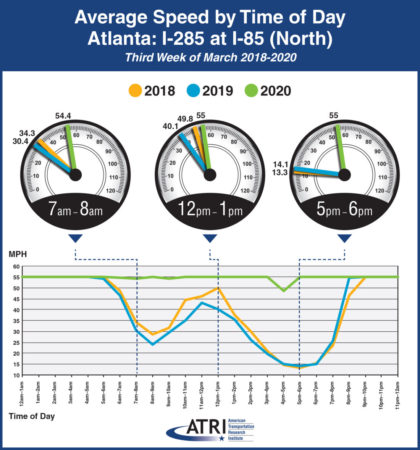Highway bottlenecks ease as truck drivers deliver the goods
ATLANTA, Ga. – Truck drivers are finding open highways during their deliveries, as non-essential workers are encouraged to stay in their homes during the fight against Covid-19 — and average speeds are rising during traditional rush hours as a result.
“Not only are trucks continuing to move, but they are doing so at speeds well in excess of normal traffic patterns,” said Rebecca Brewster, president of the American Transportation Research Institute (ATRI), which compiles real-time GPS data from more than a million trucks.
 Speeds at the intersection of I-85 and I-285 in Atlanta, an area known locally as Spaghetti Junction, are typically no faster than 24 km/h (15 mph) during afternoon rush hours. Last week, monitored truck speeds averaged 85 km/h (53 mph).
Speeds at the intersection of I-85 and I-285 in Atlanta, an area known locally as Spaghetti Junction, are typically no faster than 24 km/h (15 mph) during afternoon rush hours. Last week, monitored truck speeds averaged 85 km/h (53 mph).
“Spaghetti Junction is typical of what we’ve seen across the country, especially in areas hit hard by the virus and subject to quarantines and lockdowns,” she said. “As other traffic dissipates, trucks continue to move, delivering much-needed relief supplies to markets, hospitals, gas stations, and other essential businesses.”
Afternoon rush hours along I-495 in Queens, N.Y., typically mean truck speeds of around 26 km/h (16 mph), but they have more than doubled to 61 km/h (38 mph). Where speeds are typically below 40 km/h (25 mph) at the intersection of I-710 and I-105 in Los Angeles between 6 and 8 a.m., trucks are now averaging 85 km/h (53 mph).
At the Byrne Interchange in Chicago, where I-290 intersects with I-90/I-94, typical morning rush hours now move at 69 km/h (43 mph) compared to 32 km/h (20 mph).
“The urban centers, such as Chicago, are like ghost towns,” confirms Ritch Thiessen, a driver with Ontario-based Erb Transport.
Lighter commuter volumes don’t appear to be limited to the U.S., either. Lyoness Woodstock, also an Erb driver says he has been able to travel through Toronto and Montreal without dipping below 100 km/h. Usually that isn’t possible, he says.
The higher speeds are not a result of lower commuter traffic alone. ATRI notes that 24/7 trucking operations generate higher average truck speeds most hours of the day.
Have your say
This is a moderated forum. Comments will no longer be published unless they are accompanied by a first and last name and a verifiable email address. (Today's Trucking will not publish or share the email address.) Profane language and content deemed to be libelous, racist, or threatening in nature will not be published under any circumstances.